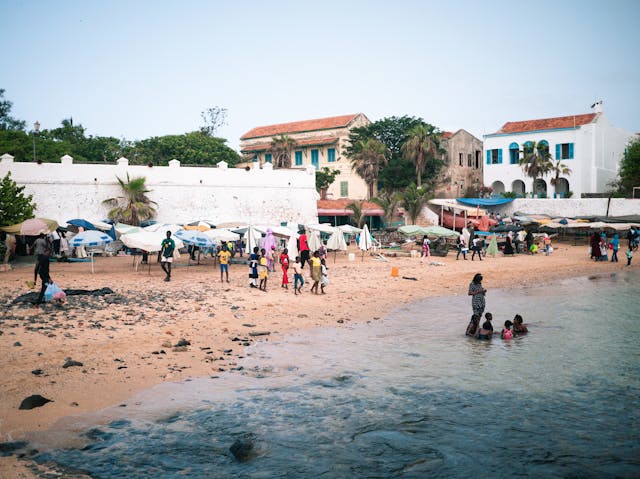Wolof Language Phrases and Basics for First-Time Learners
Planning a trip to Senegal? Whether you're exploring the streets of Dakar, heading out to Saint-Louis, or connecting with the local culture during a festival, picking up some Wolof is one of the smartest ways to enrich your experience. But what is Wolof, exactly?
Wolof is a West African language spoken mainly in Senegal, where it’s the most widely used language in everyday life, as well as in The Gambia and parts of Mauritania. Although French is Senegal’s official language, Wolof dominates in informal settings—from bustling markets to music and television. About 10 million people speak it as a first or second language, making it a key part of communication in the region.
Table of Contents
→Sign Up Now: Free Trial Wolof Lesson With a Native Teacher!←
In this blog, we’ll cover the basics of the Wolof language, including how to say hello in Wolof, how to count from 0 to 100, a few survival words you’ll want to remember, and much more. Plus, we’ll share tips on how to learn Wolof with native teachers who make the process fun, practical, and tailored to your goals.
10 Survival Wolof Words
Let’s start with some building blocks. These Wolof language phrases are short, powerful, and useful in nearly every interaction:
- Na nga def? – How are you?
- Maangi fi rekk – I’m fine (literally, “I am here only”)
- Waaw – How to say yes in Wolof
- Déedéet – No
- Jërëjëf – Thank you
- Ba beneen yoon – See you next time
- Naka la tudd? – What’s your name?
- Tudd naa... – My name is...
- Ndank ndank – Slowly, slowly (a classic Wolof expression that reflects the culture’s relaxed pace)
- Lu laay def? – What are you doing?
Knowing these ten Wolof words and phrases sets you up for friendly exchanges—and earns you points for trying to speak the local language.
15 Common Wolof Phrases
Once you’ve got the survival Wolof words down, these phrases will help you get around, be polite, and ask basic questions. These are perfect for travellers, volunteers, or anyone looking to connect more deeply with people in Senegal.
- Asalaam aleekum – Peace be upon you (universal greeting, Arabic-influenced)
- Wa aleekum salaam – Response to above
- Naka suba si? – How was your morning?
- Suba saangi nii rekk. – The morning is fine.
- Yangi ci jàmm? – Are you in peace? (used as a greeting)
- Yow? – And you?
- Lu ci des? – What’s new?
- Amuma xaalis. – I don’t have money.
- Baal ma. – Forgive me / I’m sorry.
- Waaw, maa ngi fi. – Yes, I’m here / present.
- Dama sonn. – I’m tired.
- Dama lekk. – I’m eating.
- Fii rekk. – Right here.
- Dem naa. – I’m going.
- Topp naa la. – I’m following you.
These Wolof phrases reflect the warmth and rhythm of Wolof-speaking communities. You’ll hear them in greetings, casual chats, and even at bus stops.

How to Say Wolof Numbers 0–100
Counting in Wolof may take some practice, but knowing at least the basics helps when buying things, haggling, or figuring out time and distance.
Let’s look at the core Wolof numbers first:
- 0 – ñaarul
- 1 – benn
- 2 – ñaar
- 3 – ñett
- 4 – ñent
- 5 – juróom
- 6 – juróom benn
- 7 – juróom ñaar
- 8 – juróom ñett
- 9 – juróom ñent
- 10 – fukk
Then multiples of 10:
- 20 – ñaar fukk
- 30 – ñett fukk
- 40 – ñent fukk
- 50 – juróom fukk
- 60 – juróom benn fukk
- 70 – juróom ñaar fukk
- 80 – juróom ñett fukk
- 90 – juróom ñent fukk
- 100 – teeméer
To form numbers in between, just combine them. For example, 23 is ñaar fukk ak ñett (twenty and three). Learning how Wolof builds numbers gives insight into how the language structures ideas—logical, rhythmic, and a little musical.
→Sign Up Now: Free Trial Wolof Lesson With a Native Teacher!←
The Wolof Language: FAQ
1. What is Wolof?
Wolof is a language spoken mainly in Senegal, The Gambia, and Mauritania. It is the most widely used language in Senegal and serves as a lingua franca across different ethnic groups. While not the official language, Wolof is dominant in everyday conversation, media, and popular culture.
2. How to say yes in Wolof?
To say yes in Wolof, use the word “waaw.” It’s pronounced like “wow” and is commonly used in everyday conversation.
3. What are some Wolof bad words?
Some Wolof bad words include "jaay doole" (weakling) or "doff" (crazy), but using insults in another culture requires caution. These terms might be playful among friends but offensive in formal or unfamiliar settings, so it's important to understand context before using them.
4. How to say hello in Wolof?
To say hello in Wolof, use “Na nga def?” for an informal “How are you?” or the universal Islamic greeting “Asalaam aleekum,” which is widely used and always appropriate. The polite reply is “Maangi fi rekk,” meaning “I’m fine.”
5. How to learn Wolof?
Listen & Learn offers one-to-one in-person Wolof courses in London and other major cities, as well as online lessons with native teachers. This personalised approach helps learners build vocabulary, improve pronunciation, and understand Wolof grammar based on their goals and learning style. Practising regularly, using phrasebooks, and immersing yourself in Senegalese culture also support the learning process.
Ready to start speaking Wolof? Contact Listen & Learn today to book your free trial lesson with a native teacher. Whether you prefer in-person classes in your city or online sessions from home, we'll match you with the perfect instructor to help you reach your goals.


